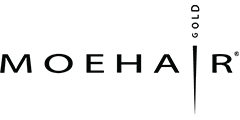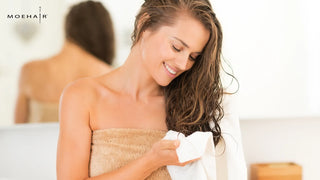 Table of contents
Table of contents
Proper haircare can reach your hair only when you know your hair type, texture, and what it needs. It's easy to de-bundle hair depending on the primary types—straight, wavy, curly, and coiled. But understanding hair goes beyond its texture. The discourse on the importance of moisture and hydration for healthy hair growth often pivots towards understanding the concept of hair porosity. Depending on whether you have high or low porosity hair, the capability of your strands to retain moisture varies.
The word porosity is no stranger, something we all recall from our science lessons in school. In layman terms, it measures the degree of porous space in a material that enables liquid passage. As told by Kari Williams, Ph.D., expert trichologist and celebrity hairstylist to Shape – "Porosity is the hair's ability to absorb moisture and keep moisture in the strands." Still confused? Don't worry; we will break it down for you, focusing on low-porosity hair care.
What is low-porosity hair?
Porosity is the ability of the hair to absorb and retain moisture. According to Robbins (2012), the cuticle is the outermost strand layer formed by flat overlapping cells, determines moisture penetration through strands. If the cuticles are raised and open, it creates space, making it easier for moisture to absorb and escape; this is called high porosity hair. On the other hand, if the cuticle is tightly closed, it leaves fewer gaps for the moisture to either absorb or escape. This is known as low porosity hair.

Determining the porosity level of hair
Now that you know about high and low porosity, it's time to determine your hair time. Take a dry and clean strand of your hair and put it into a cup of water. Depending on how long it takes to sink to the bottom, you can determine the porosity level. For high-porosity hair, the strand will sink almost immediately; medium-porosity hair will sink after a few seconds, whereas low-porosity hair takes longer to sink.
Characteristics of low porosity hair
If your hair has low porosity, these are some of the signs you need to look out for:- Dryness is one of the signs due to the strand's inability to absorb moisture. As Jennie Roberts, Curlsmith's global brand ambassador to InStyle, says, "Low-porosity hair acts like it's waterproof." This, in turn, makes it dry and dehydrated.
- If wetting hair while cleansing as well as drying takes longer, you likely have low porosity hair.
- The application of products often makes hair greasy and oily. Because of low porosity, products are not absorbed well and sit on hair instead of being absorbed.
- Due to its coarse and brittle strands, it is prone to tangling, which in turn leads to breakage and even split ends.
Tips to take care of low porosity

If you have curly or coiled hair with low porosity, it's challenging to keep it hydrated and moisturized. We feel you, darling; we really do. But on the brighter side, you can take care of it by adopting a healthy, low-porosity hair routine. We give you all the insider tips to manage dryness, retain moisture, and improve wholesome strand health.
Deep cleanse once or twice a month
As the strands are prone to buildup, it further hinders the absorption of hydrating products. This makes it crucial to deep cleanse, detox, and eliminate buildup. A good clarifying shampoo is your friend, helping to keep the buildup, oil, and grease in check. We recommend trying Moehair Clarifying Shampoo for a thorough cleanse.
Use a pre-poo before shampooing
If you need clarification about pre-poo, here's a quick bite. It is also known as pre-shampoo, a product that prepares your hair for shampoo. It's a protective treatment before using shampoo and conditioner. This works on hydrating the hair and prevents the shampoo from stripping off the moisture. Hence, adding pre-poo to a low-porosity haircare routine prevents hair from drying.
Use lightweight oils
Gently massage your scalp and apply oil along the length of your hair. Opt for a lightweight oil like almond, argan, or coconut oil to enable penetration past the tight cuticles. The saturated fat in the oil helps moisturize rough and dry hair. Leave the oil for at least 30 – 45 minutes before washing off. We recommend trying Moehair Sunflower Oil, Moehair Safflower Oil, or Moehair Organic Golden Jojoba Oil.
Use steam on hair
Steam treatment is another effective way to open up the hair cuticles. As the heat from the steam relaxes and opens the cuticles, moisture penetrates into the strands, helping to absorb moisturizing products more easily. However, be careful not to steam the hair frequently, as too much heat might be damaging.
Opt for a moisturizing hair care regime
Low-porosity hair needs lightweight, moisturizing products to nourish and hydrate the strands. Instead of using thick, cream-based products, try sprays or liquid formulations. Invest in a moisturizing shampoo and conditioner. We recommend trying Moehair Hi-Vibes Vegan Moisturizing Shampoo and Conditioner for gently cleansing and nourishing hair. For dry hair, use a leave-on product like Moehair Leave-In Conditioner to lock in hydration.
Revive strands with deep conditioning
Due to its inability to absorb moisture, low-porosity hair often appears dry. However, using a deep conditioning and hydrating hair mask helps soften hair. Use a hydrating hair mask once a week, wrap it in a warm towel, and leave it on for 5 to 10 minutes. This helps open the cuticles, and hence, products are absorbed better. As a result, it gives hair the much-needed long-lasting moisture.
Avoid heavy textured products
Low-porosity hair finds it difficult to absorb products, which might lead to product accumulation. Avoid using too many protein-rich products, as additional proteins might make hair stiffer and prone to breakage. Opt for products enriched with natural oil, as it nourishes the strands. Do not use products that have a creamy or buttery texture, as they are heavier and might sit on strands. As a result, they cause buildup on hair and scalp, further hindering the ability of the strand to absorb moisture.
If you find it challenging to keep your hair nourished and moisturized, there is a probability that you have low-porosity hair. However, using the right haircare regimen and the appropriate products makes it convenient to turn those stiff strands smoother and shinier.
References
https://www.shape.com/lifestyle/beauty-style/low-high-porosity-hairhttps://www.ncbi.nlm.nih.gov/pmc/articles/PMC4201279/#ref-50
https://www.instyle.com/low-porosity-hair-treatment-7112156
How we reviewed this article:
Our experts continually monitor the fashion and beauty space, and we update our articles when new information becomes available.
-
Current Version
-
March 22, 2024
Written By -
Upasana Kakati is a lifestyle writer with 7+ years of experience in writing in the beauty and haircare industry.
Edited By -
Saima Ahmed with 8+ yrs of experience, specializes in crafting engaging content focused on Hair care, lifestyle, and beauty.






















